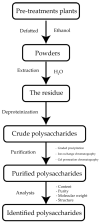Review on Modification of Glucomannan as an Excipient in Solid Dosage Forms
- PMID: 35808596
- PMCID: PMC9269564
- DOI: 10.3390/polym14132550
Review on Modification of Glucomannan as an Excipient in Solid Dosage Forms
Abstract
Glucomannan (GM)-a polysaccharide generally extracted from the tuber of Amorphophallus konjac-has great potential as a filler-binder in direct compression, disintegrant in tablets, or gelling agent due to its strong hydrophilicity and extremely high viscosity. However, it has poor water resistance and low mechanical strength when used as an excipient in solid form. Several physical and chemical modifications have been carried out to improve these drawbacks. Chemical modification affects the characteristics of GM based on the DS. Carboxymethylation improves GM functionality by modifying its solubility and viscosity, which in turn allows it to bind water more efficiently and thus improve its elongation and gel homogeneity. Meanwhile, physical modification enhances functionality through combination with other excipients to improve mechanical properties and modify swelling ability and drug release from the matrix. This review discusses extraction of GM and its modification to enhance its applicability as an excipient in solid form. Modified GM is a novel excipient applicable in the pharmaceutical industry for direct compression, as a tablet disintegrant, a film-forming agent, and for encapsulation of macromolecular compounds or drug carriers for controlled release.
Keywords: chemical modification; excipient; glucomannan; physical modification.
Conflict of interest statement
The authors declare no conflict of interest.
Figures








Similar articles
-
Modification of glucomannan of Amorphophallus oncophyllus as an excipient for iron encapsulation performed using the gelation method.Acta Sci Pol Technol Aliment. 2019 Apr-Jun;18(2):173-184. doi: 10.17306/J.AFS.0651. Acta Sci Pol Technol Aliment. 2019. PMID: 31256545
-
A novel superdisintegrating agent made from physically modified chitosan with silicon dioxide.Drug Dev Ind Pharm. 2008 Apr;34(4):373-83. doi: 10.1080/03639040701657792. Drug Dev Ind Pharm. 2008. PMID: 18401779
-
Konjac glucomannan, a promising polysaccharide for OCDDS.Carbohydr Polym. 2014 Apr 15;104:175-81. doi: 10.1016/j.carbpol.2013.12.081. Epub 2014 Jan 19. Carbohydr Polym. 2014. PMID: 24607175 Review.
-
Studies on stercuia gum formulations in the form of osmotic core tablet for colon-specific drug delivery of azathioprine.PDA J Pharm Sci Technol. 2013 Mar-Apr;67(2):172-84. doi: 10.5731/pdajpst.2013.00913. PDA J Pharm Sci Technol. 2013. PMID: 23569078
-
Relationship between compression pressure, mechanical strength and release properties of tablets.Polim Med. 2019 Jan-Jun;49(1):27-33. doi: 10.17219/pim/111888. Polim Med. 2019. PMID: 31756061 Review.
Cited by
-
Recent Progress on Modified Gum Katira Polysaccharides and Their Various Potential Applications.Polymers (Basel). 2022 Sep 2;14(17):3648. doi: 10.3390/polym14173648. Polymers (Basel). 2022. PMID: 36080723 Free PMC article. Review.
-
Merging konjac glucomannan with other copolymeric hydrogels as a cutting-edge liquid raft system for dual delivery of etoricoxib and famotidine.Drug Deliv. 2023 Dec;30(1):2189630. doi: 10.1080/10717544.2023.2189630. Drug Deliv. 2023. PMID: 36927148 Free PMC article.
-
A Novel Konjac Powder with High Compressibility, High Water-Holding Capacity, and High Expansion Force.Foods. 2025 Jan 11;14(2):211. doi: 10.3390/foods14020211. Foods. 2025. PMID: 39856878 Free PMC article.
-
Carboxymethylated Gums and Derivatization: Strategies and Significance in Drug Delivery and Tissue Engineering.Pharmaceuticals (Basel). 2023 May 22;16(5):776. doi: 10.3390/ph16050776. Pharmaceuticals (Basel). 2023. PMID: 37242559 Free PMC article. Review.
References
-
- Wang L.H., Huang G.Q., Xu T.C., Xiao J.X. Characterization of carboxymethylated konjac glucomannan for potential application in colon-targeted delivery. Food Hydrocoll. 2019;94:354–362. doi: 10.1016/j.foodhyd.2019.03.045. - DOI
-
- Xiao C., Weng L., Zhang L. Improvement of physical properties of crosslinked alginate and carboxymethyl konjac glucomannan blend films. J. Appl. Polym. Sci. 2002;84:2554–2560. doi: 10.1002/app.10582. - DOI
Publication types
Grants and funding
LinkOut - more resources
Full Text Sources

